Strategic Information Systems for Business and Enterprise
VerifiedAdded on 2023/01/11
|8
|2300
|41
AI Summary
This document discusses the importance of strategic information systems for business and enterprise. It explores the relationship between data, information, and information systems. It also covers fraud prevention and detection measures, advanced technology for credit checks, and internal control weaknesses in cash disbursement systems. Course code: 1
Contribute Materials
Your contribution can guide someone’s learning journey. Share your
documents today.
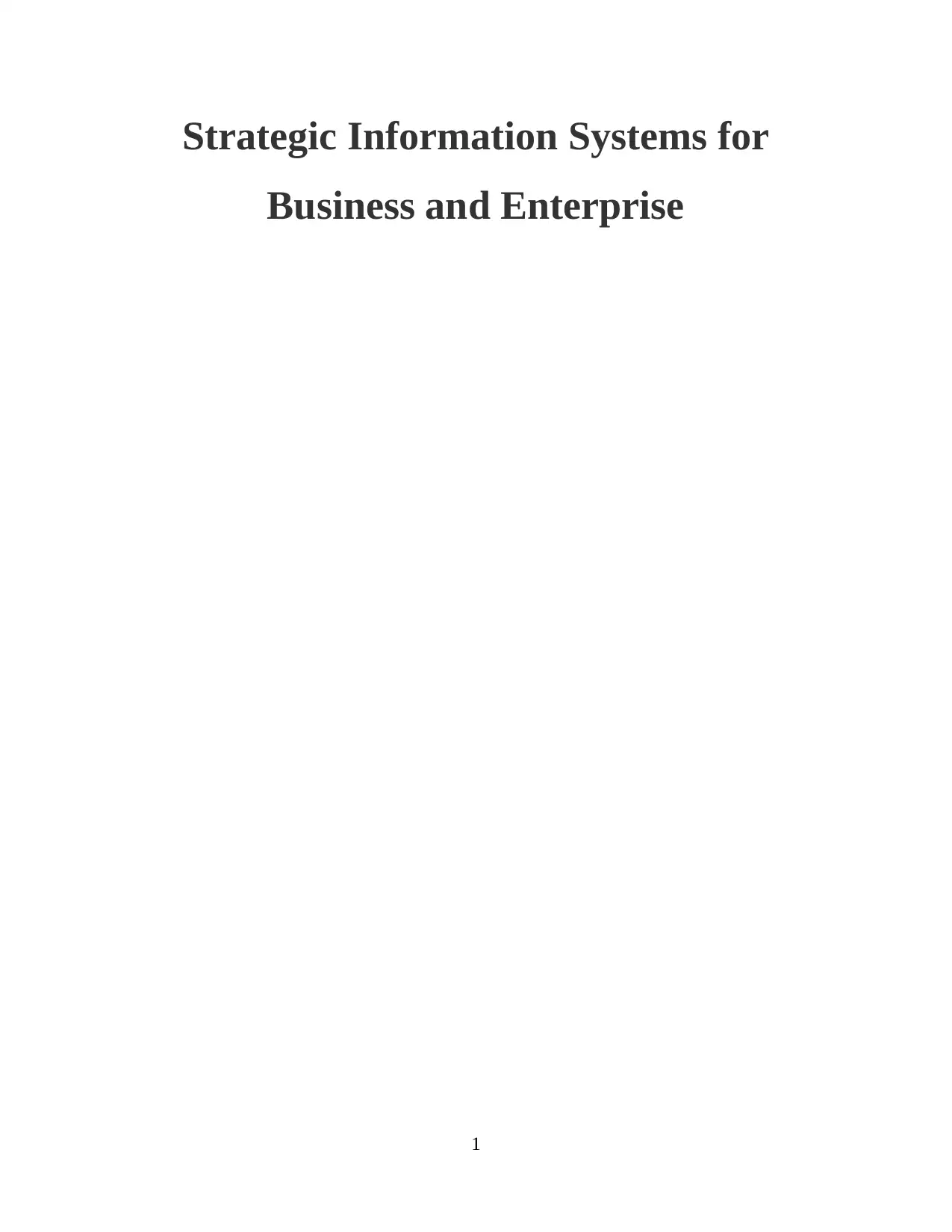
Strategic Information Systems for
Business and Enterprise
1
Business and Enterprise
1
Secure Best Marks with AI Grader
Need help grading? Try our AI Grader for instant feedback on your assignments.
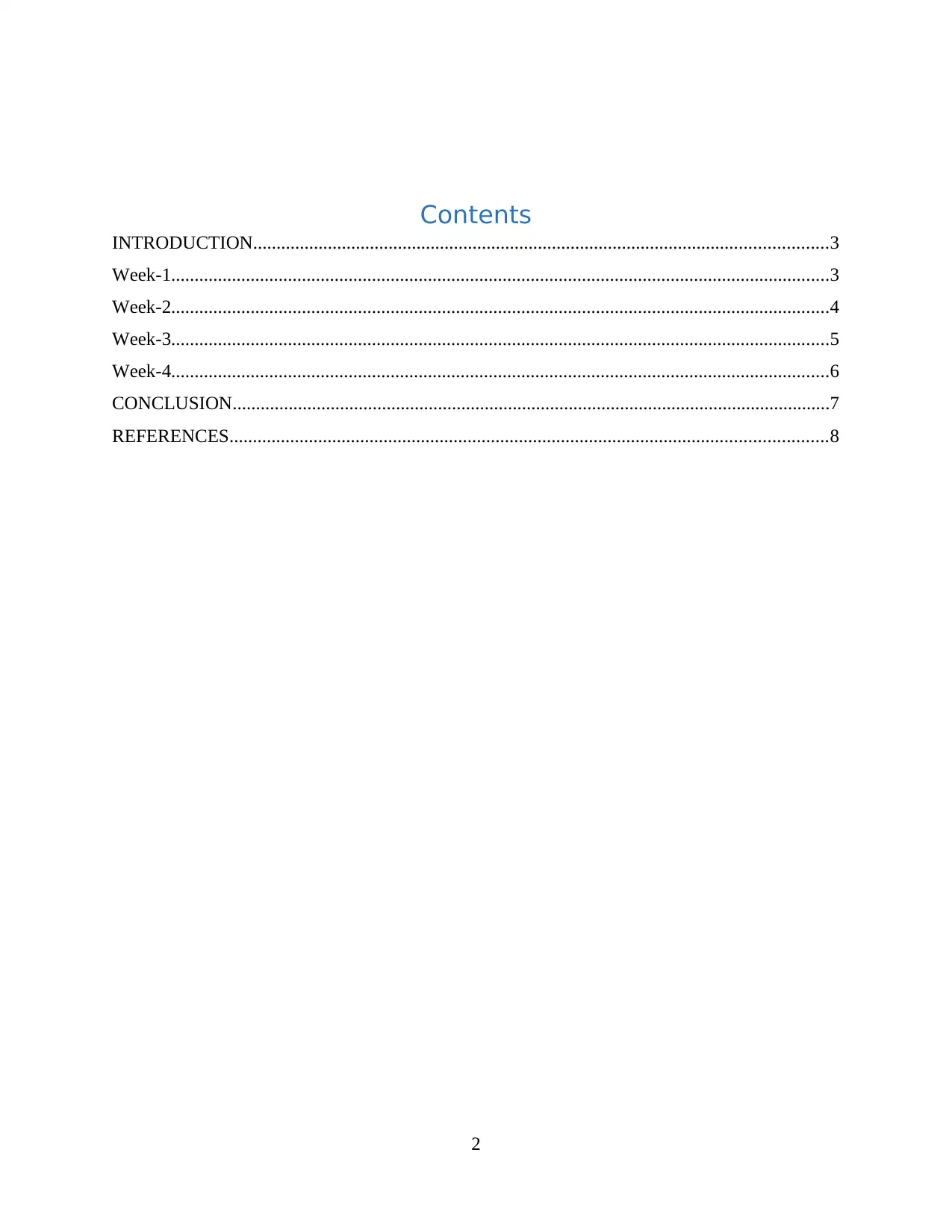
Contents
INTRODUCTION...........................................................................................................................3
Week-1.............................................................................................................................................3
Week-2.............................................................................................................................................4
Week-3.............................................................................................................................................5
Week-4.............................................................................................................................................6
CONCLUSION................................................................................................................................7
REFERENCES................................................................................................................................8
2
INTRODUCTION...........................................................................................................................3
Week-1.............................................................................................................................................3
Week-2.............................................................................................................................................4
Week-3.............................................................................................................................................5
Week-4.............................................................................................................................................6
CONCLUSION................................................................................................................................7
REFERENCES................................................................................................................................8
2
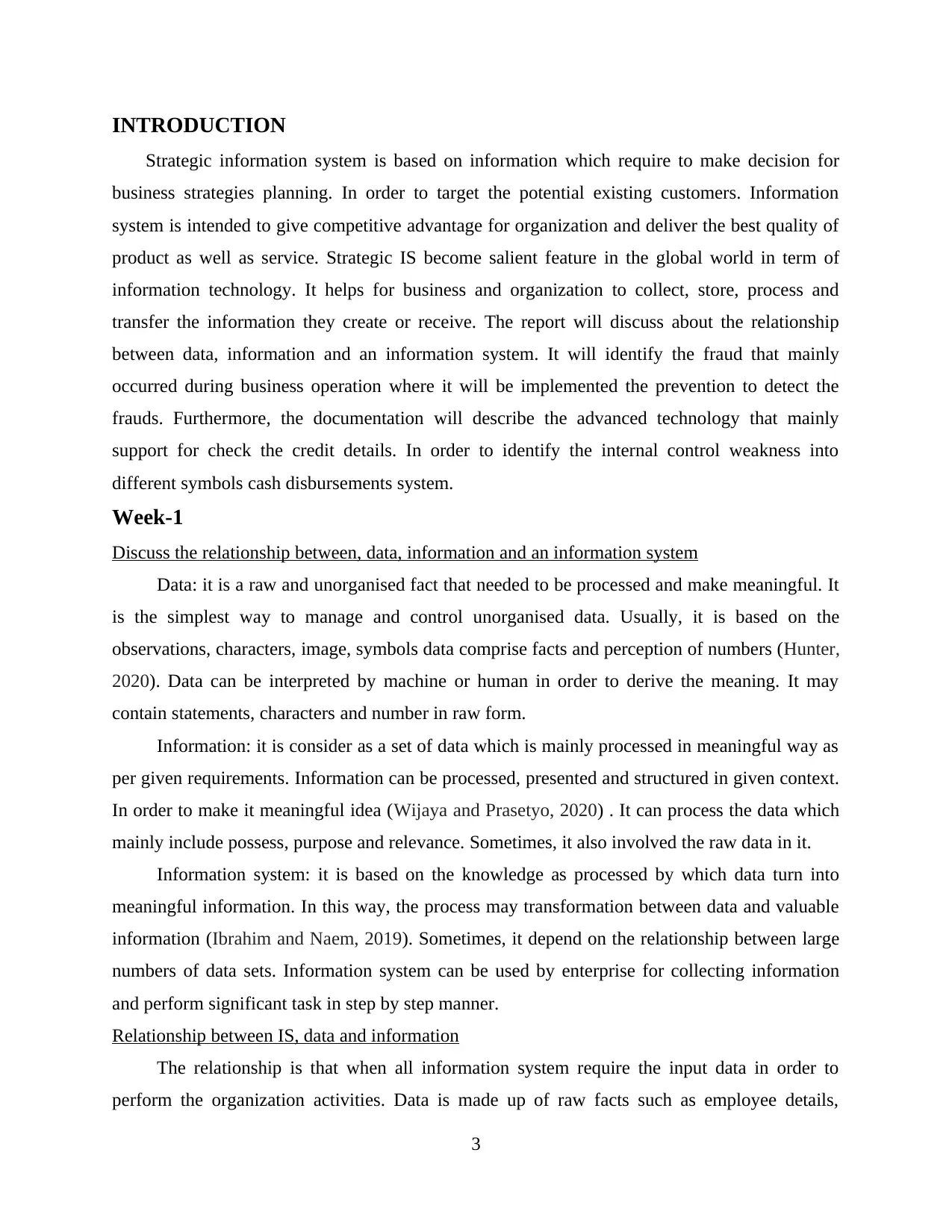
INTRODUCTION
Strategic information system is based on information which require to make decision for
business strategies planning. In order to target the potential existing customers. Information
system is intended to give competitive advantage for organization and deliver the best quality of
product as well as service. Strategic IS become salient feature in the global world in term of
information technology. It helps for business and organization to collect, store, process and
transfer the information they create or receive. The report will discuss about the relationship
between data, information and an information system. It will identify the fraud that mainly
occurred during business operation where it will be implemented the prevention to detect the
frauds. Furthermore, the documentation will describe the advanced technology that mainly
support for check the credit details. In order to identify the internal control weakness into
different symbols cash disbursements system.
Week-1
Discuss the relationship between, data, information and an information system
Data: it is a raw and unorganised fact that needed to be processed and make meaningful. It
is the simplest way to manage and control unorganised data. Usually, it is based on the
observations, characters, image, symbols data comprise facts and perception of numbers (Hunter,
2020). Data can be interpreted by machine or human in order to derive the meaning. It may
contain statements, characters and number in raw form.
Information: it is consider as a set of data which is mainly processed in meaningful way as
per given requirements. Information can be processed, presented and structured in given context.
In order to make it meaningful idea (Wijaya and Prasetyo, 2020) . It can process the data which
mainly include possess, purpose and relevance. Sometimes, it also involved the raw data in it.
Information system: it is based on the knowledge as processed by which data turn into
meaningful information. In this way, the process may transformation between data and valuable
information (Ibrahim and Naem, 2019). Sometimes, it depend on the relationship between large
numbers of data sets. Information system can be used by enterprise for collecting information
and perform significant task in step by step manner.
Relationship between IS, data and information
The relationship is that when all information system require the input data in order to
perform the organization activities. Data is made up of raw facts such as employee details,
3
Strategic information system is based on information which require to make decision for
business strategies planning. In order to target the potential existing customers. Information
system is intended to give competitive advantage for organization and deliver the best quality of
product as well as service. Strategic IS become salient feature in the global world in term of
information technology. It helps for business and organization to collect, store, process and
transfer the information they create or receive. The report will discuss about the relationship
between data, information and an information system. It will identify the fraud that mainly
occurred during business operation where it will be implemented the prevention to detect the
frauds. Furthermore, the documentation will describe the advanced technology that mainly
support for check the credit details. In order to identify the internal control weakness into
different symbols cash disbursements system.
Week-1
Discuss the relationship between, data, information and an information system
Data: it is a raw and unorganised fact that needed to be processed and make meaningful. It
is the simplest way to manage and control unorganised data. Usually, it is based on the
observations, characters, image, symbols data comprise facts and perception of numbers (Hunter,
2020). Data can be interpreted by machine or human in order to derive the meaning. It may
contain statements, characters and number in raw form.
Information: it is consider as a set of data which is mainly processed in meaningful way as
per given requirements. Information can be processed, presented and structured in given context.
In order to make it meaningful idea (Wijaya and Prasetyo, 2020) . It can process the data which
mainly include possess, purpose and relevance. Sometimes, it also involved the raw data in it.
Information system: it is based on the knowledge as processed by which data turn into
meaningful information. In this way, the process may transformation between data and valuable
information (Ibrahim and Naem, 2019). Sometimes, it depend on the relationship between large
numbers of data sets. Information system can be used by enterprise for collecting information
and perform significant task in step by step manner.
Relationship between IS, data and information
The relationship is that when all information system require the input data in order to
perform the organization activities. Data is made up of raw facts such as employee details,
3
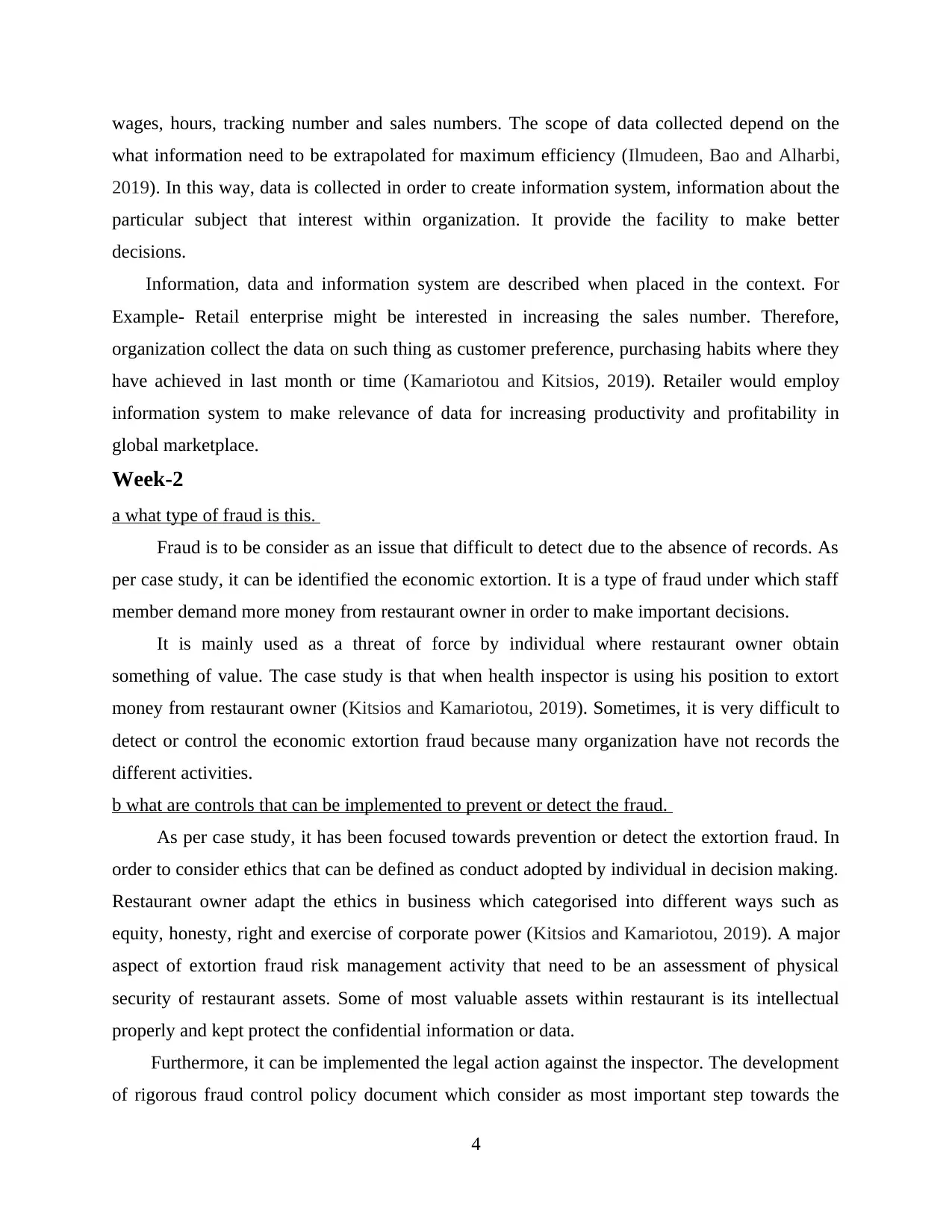
wages, hours, tracking number and sales numbers. The scope of data collected depend on the
what information need to be extrapolated for maximum efficiency (Ilmudeen, Bao and Alharbi,
2019). In this way, data is collected in order to create information system, information about the
particular subject that interest within organization. It provide the facility to make better
decisions.
Information, data and information system are described when placed in the context. For
Example- Retail enterprise might be interested in increasing the sales number. Therefore,
organization collect the data on such thing as customer preference, purchasing habits where they
have achieved in last month or time (Kamariotou and Kitsios, 2019). Retailer would employ
information system to make relevance of data for increasing productivity and profitability in
global marketplace.
Week-2
a what type of fraud is this.
Fraud is to be consider as an issue that difficult to detect due to the absence of records. As
per case study, it can be identified the economic extortion. It is a type of fraud under which staff
member demand more money from restaurant owner in order to make important decisions.
It is mainly used as a threat of force by individual where restaurant owner obtain
something of value. The case study is that when health inspector is using his position to extort
money from restaurant owner (Kitsios and Kamariotou, 2019). Sometimes, it is very difficult to
detect or control the economic extortion fraud because many organization have not records the
different activities.
b what are controls that can be implemented to prevent or detect the fraud.
As per case study, it has been focused towards prevention or detect the extortion fraud. In
order to consider ethics that can be defined as conduct adopted by individual in decision making.
Restaurant owner adapt the ethics in business which categorised into different ways such as
equity, honesty, right and exercise of corporate power (Kitsios and Kamariotou, 2019). A major
aspect of extortion fraud risk management activity that need to be an assessment of physical
security of restaurant assets. Some of most valuable assets within restaurant is its intellectual
properly and kept protect the confidential information or data.
Furthermore, it can be implemented the legal action against the inspector. The development
of rigorous fraud control policy document which consider as most important step towards the
4
what information need to be extrapolated for maximum efficiency (Ilmudeen, Bao and Alharbi,
2019). In this way, data is collected in order to create information system, information about the
particular subject that interest within organization. It provide the facility to make better
decisions.
Information, data and information system are described when placed in the context. For
Example- Retail enterprise might be interested in increasing the sales number. Therefore,
organization collect the data on such thing as customer preference, purchasing habits where they
have achieved in last month or time (Kamariotou and Kitsios, 2019). Retailer would employ
information system to make relevance of data for increasing productivity and profitability in
global marketplace.
Week-2
a what type of fraud is this.
Fraud is to be consider as an issue that difficult to detect due to the absence of records. As
per case study, it can be identified the economic extortion. It is a type of fraud under which staff
member demand more money from restaurant owner in order to make important decisions.
It is mainly used as a threat of force by individual where restaurant owner obtain
something of value. The case study is that when health inspector is using his position to extort
money from restaurant owner (Kitsios and Kamariotou, 2019). Sometimes, it is very difficult to
detect or control the economic extortion fraud because many organization have not records the
different activities.
b what are controls that can be implemented to prevent or detect the fraud.
As per case study, it has been focused towards prevention or detect the extortion fraud. In
order to consider ethics that can be defined as conduct adopted by individual in decision making.
Restaurant owner adapt the ethics in business which categorised into different ways such as
equity, honesty, right and exercise of corporate power (Kitsios and Kamariotou, 2019). A major
aspect of extortion fraud risk management activity that need to be an assessment of physical
security of restaurant assets. Some of most valuable assets within restaurant is its intellectual
properly and kept protect the confidential information or data.
Furthermore, it can be implemented the legal action against the inspector. The development
of rigorous fraud control policy document which consider as most important step towards the
4
Paraphrase This Document
Need a fresh take? Get an instant paraphrase of this document with our AI Paraphraser
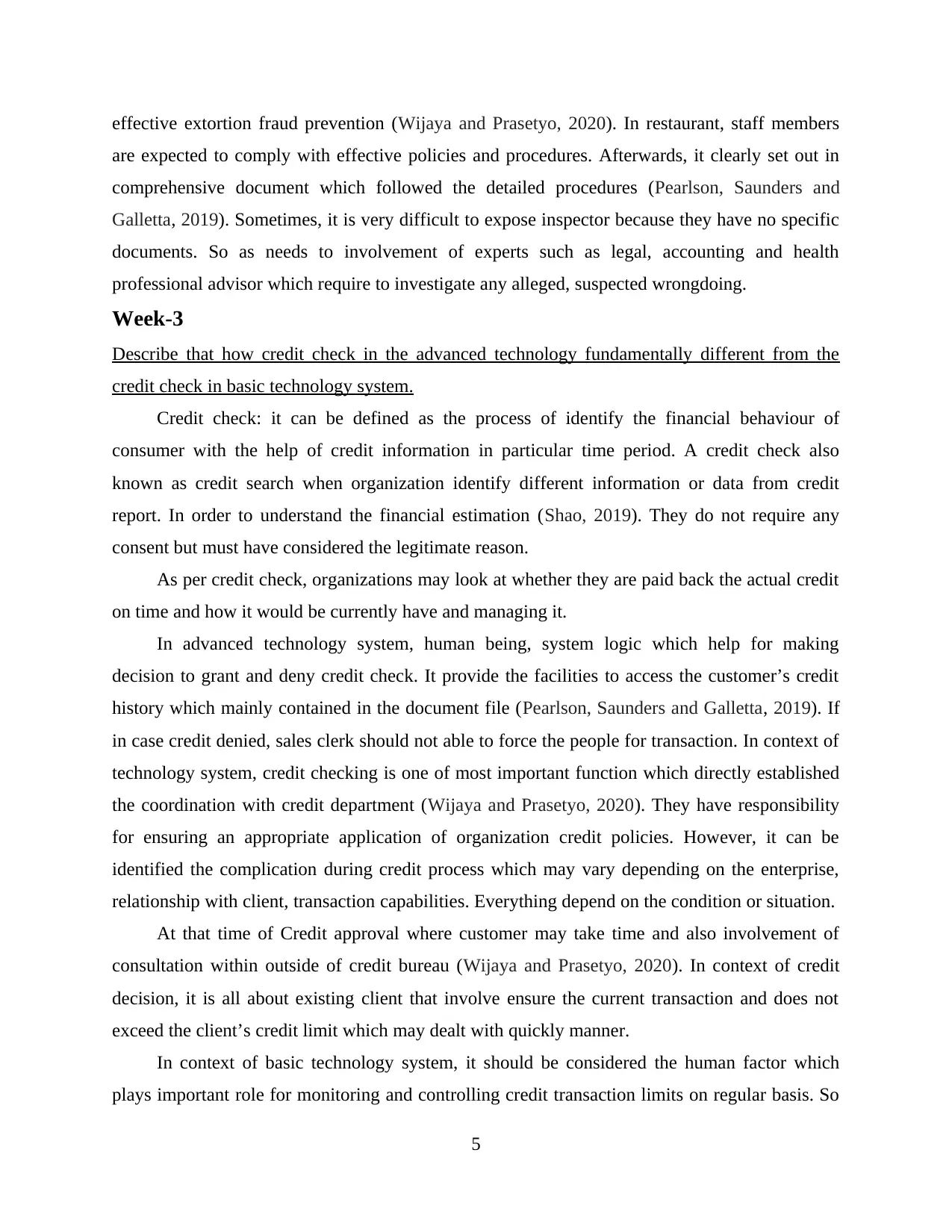
effective extortion fraud prevention (Wijaya and Prasetyo, 2020). In restaurant, staff members
are expected to comply with effective policies and procedures. Afterwards, it clearly set out in
comprehensive document which followed the detailed procedures (Pearlson, Saunders and
Galletta, 2019). Sometimes, it is very difficult to expose inspector because they have no specific
documents. So as needs to involvement of experts such as legal, accounting and health
professional advisor which require to investigate any alleged, suspected wrongdoing.
Week-3
Describe that how credit check in the advanced technology fundamentally different from the
credit check in basic technology system.
Credit check: it can be defined as the process of identify the financial behaviour of
consumer with the help of credit information in particular time period. A credit check also
known as credit search when organization identify different information or data from credit
report. In order to understand the financial estimation (Shao, 2019). They do not require any
consent but must have considered the legitimate reason.
As per credit check, organizations may look at whether they are paid back the actual credit
on time and how it would be currently have and managing it.
In advanced technology system, human being, system logic which help for making
decision to grant and deny credit check. It provide the facilities to access the customer’s credit
history which mainly contained in the document file (Pearlson, Saunders and Galletta, 2019). If
in case credit denied, sales clerk should not able to force the people for transaction. In context of
technology system, credit checking is one of most important function which directly established
the coordination with credit department (Wijaya and Prasetyo, 2020). They have responsibility
for ensuring an appropriate application of organization credit policies. However, it can be
identified the complication during credit process which may vary depending on the enterprise,
relationship with client, transaction capabilities. Everything depend on the condition or situation.
At that time of Credit approval where customer may take time and also involvement of
consultation within outside of credit bureau (Wijaya and Prasetyo, 2020). In context of credit
decision, it is all about existing client that involve ensure the current transaction and does not
exceed the client’s credit limit which may dealt with quickly manner.
In context of basic technology system, it should be considered the human factor which
plays important role for monitoring and controlling credit transaction limits on regular basis. So
5
are expected to comply with effective policies and procedures. Afterwards, it clearly set out in
comprehensive document which followed the detailed procedures (Pearlson, Saunders and
Galletta, 2019). Sometimes, it is very difficult to expose inspector because they have no specific
documents. So as needs to involvement of experts such as legal, accounting and health
professional advisor which require to investigate any alleged, suspected wrongdoing.
Week-3
Describe that how credit check in the advanced technology fundamentally different from the
credit check in basic technology system.
Credit check: it can be defined as the process of identify the financial behaviour of
consumer with the help of credit information in particular time period. A credit check also
known as credit search when organization identify different information or data from credit
report. In order to understand the financial estimation (Shao, 2019). They do not require any
consent but must have considered the legitimate reason.
As per credit check, organizations may look at whether they are paid back the actual credit
on time and how it would be currently have and managing it.
In advanced technology system, human being, system logic which help for making
decision to grant and deny credit check. It provide the facilities to access the customer’s credit
history which mainly contained in the document file (Pearlson, Saunders and Galletta, 2019). If
in case credit denied, sales clerk should not able to force the people for transaction. In context of
technology system, credit checking is one of most important function which directly established
the coordination with credit department (Wijaya and Prasetyo, 2020). They have responsibility
for ensuring an appropriate application of organization credit policies. However, it can be
identified the complication during credit process which may vary depending on the enterprise,
relationship with client, transaction capabilities. Everything depend on the condition or situation.
At that time of Credit approval where customer may take time and also involvement of
consultation within outside of credit bureau (Wijaya and Prasetyo, 2020). In context of credit
decision, it is all about existing client that involve ensure the current transaction and does not
exceed the client’s credit limit which may dealt with quickly manner.
In context of basic technology system, it should be considered the human factor which
plays important role for monitoring and controlling credit transaction limits on regular basis. So
5
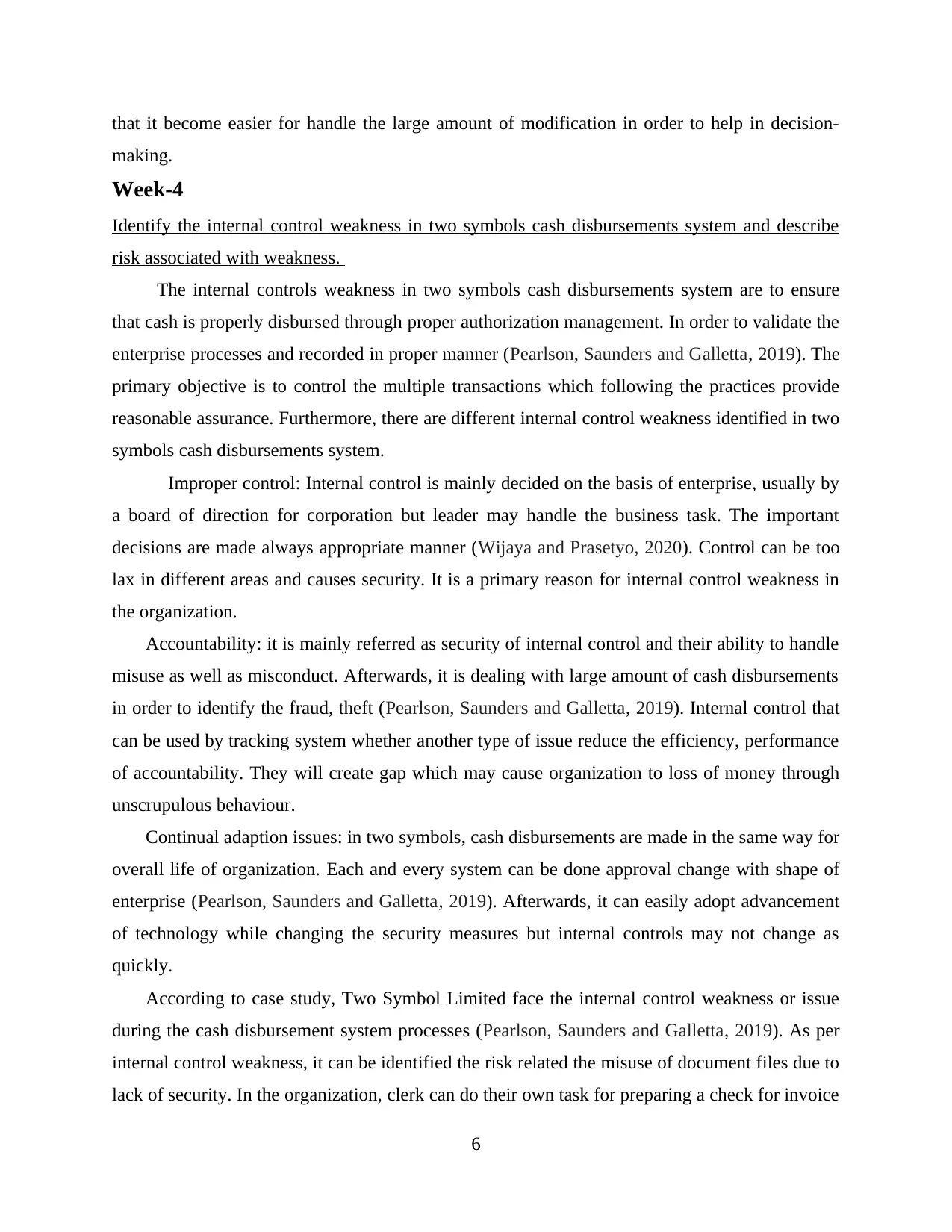
that it become easier for handle the large amount of modification in order to help in decision-
making.
Week-4
Identify the internal control weakness in two symbols cash disbursements system and describe
risk associated with weakness.
The internal controls weakness in two symbols cash disbursements system are to ensure
that cash is properly disbursed through proper authorization management. In order to validate the
enterprise processes and recorded in proper manner (Pearlson, Saunders and Galletta, 2019). The
primary objective is to control the multiple transactions which following the practices provide
reasonable assurance. Furthermore, there are different internal control weakness identified in two
symbols cash disbursements system.
Improper control: Internal control is mainly decided on the basis of enterprise, usually by
a board of direction for corporation but leader may handle the business task. The important
decisions are made always appropriate manner (Wijaya and Prasetyo, 2020). Control can be too
lax in different areas and causes security. It is a primary reason for internal control weakness in
the organization.
Accountability: it is mainly referred as security of internal control and their ability to handle
misuse as well as misconduct. Afterwards, it is dealing with large amount of cash disbursements
in order to identify the fraud, theft (Pearlson, Saunders and Galletta, 2019). Internal control that
can be used by tracking system whether another type of issue reduce the efficiency, performance
of accountability. They will create gap which may cause organization to loss of money through
unscrupulous behaviour.
Continual adaption issues: in two symbols, cash disbursements are made in the same way for
overall life of organization. Each and every system can be done approval change with shape of
enterprise (Pearlson, Saunders and Galletta, 2019). Afterwards, it can easily adopt advancement
of technology while changing the security measures but internal controls may not change as
quickly.
According to case study, Two Symbol Limited face the internal control weakness or issue
during the cash disbursement system processes (Pearlson, Saunders and Galletta, 2019). As per
internal control weakness, it can be identified the risk related the misuse of document files due to
lack of security. In the organization, clerk can do their own task for preparing a check for invoice
6
making.
Week-4
Identify the internal control weakness in two symbols cash disbursements system and describe
risk associated with weakness.
The internal controls weakness in two symbols cash disbursements system are to ensure
that cash is properly disbursed through proper authorization management. In order to validate the
enterprise processes and recorded in proper manner (Pearlson, Saunders and Galletta, 2019). The
primary objective is to control the multiple transactions which following the practices provide
reasonable assurance. Furthermore, there are different internal control weakness identified in two
symbols cash disbursements system.
Improper control: Internal control is mainly decided on the basis of enterprise, usually by
a board of direction for corporation but leader may handle the business task. The important
decisions are made always appropriate manner (Wijaya and Prasetyo, 2020). Control can be too
lax in different areas and causes security. It is a primary reason for internal control weakness in
the organization.
Accountability: it is mainly referred as security of internal control and their ability to handle
misuse as well as misconduct. Afterwards, it is dealing with large amount of cash disbursements
in order to identify the fraud, theft (Pearlson, Saunders and Galletta, 2019). Internal control that
can be used by tracking system whether another type of issue reduce the efficiency, performance
of accountability. They will create gap which may cause organization to loss of money through
unscrupulous behaviour.
Continual adaption issues: in two symbols, cash disbursements are made in the same way for
overall life of organization. Each and every system can be done approval change with shape of
enterprise (Pearlson, Saunders and Galletta, 2019). Afterwards, it can easily adopt advancement
of technology while changing the security measures but internal controls may not change as
quickly.
According to case study, Two Symbol Limited face the internal control weakness or issue
during the cash disbursement system processes (Pearlson, Saunders and Galletta, 2019). As per
internal control weakness, it can be identified the risk related the misuse of document files due to
lack of security. In the organization, clerk can do their own task for preparing a check for invoice
6
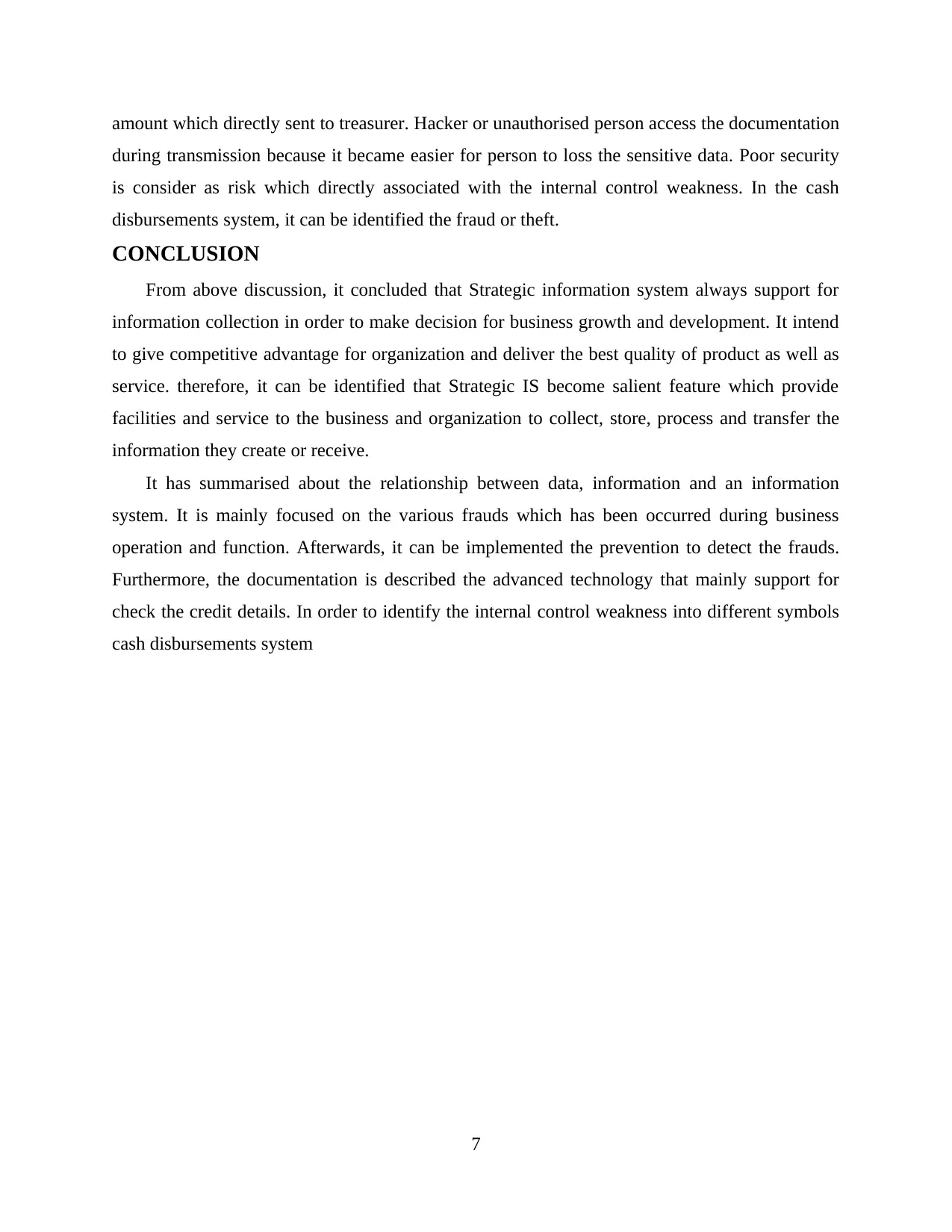
amount which directly sent to treasurer. Hacker or unauthorised person access the documentation
during transmission because it became easier for person to loss the sensitive data. Poor security
is consider as risk which directly associated with the internal control weakness. In the cash
disbursements system, it can be identified the fraud or theft.
CONCLUSION
From above discussion, it concluded that Strategic information system always support for
information collection in order to make decision for business growth and development. It intend
to give competitive advantage for organization and deliver the best quality of product as well as
service. therefore, it can be identified that Strategic IS become salient feature which provide
facilities and service to the business and organization to collect, store, process and transfer the
information they create or receive.
It has summarised about the relationship between data, information and an information
system. It is mainly focused on the various frauds which has been occurred during business
operation and function. Afterwards, it can be implemented the prevention to detect the frauds.
Furthermore, the documentation is described the advanced technology that mainly support for
check the credit details. In order to identify the internal control weakness into different symbols
cash disbursements system
7
during transmission because it became easier for person to loss the sensitive data. Poor security
is consider as risk which directly associated with the internal control weakness. In the cash
disbursements system, it can be identified the fraud or theft.
CONCLUSION
From above discussion, it concluded that Strategic information system always support for
information collection in order to make decision for business growth and development. It intend
to give competitive advantage for organization and deliver the best quality of product as well as
service. therefore, it can be identified that Strategic IS become salient feature which provide
facilities and service to the business and organization to collect, store, process and transfer the
information they create or receive.
It has summarised about the relationship between data, information and an information
system. It is mainly focused on the various frauds which has been occurred during business
operation and function. Afterwards, it can be implemented the prevention to detect the frauds.
Furthermore, the documentation is described the advanced technology that mainly support for
check the credit details. In order to identify the internal control weakness into different symbols
cash disbursements system
7
Secure Best Marks with AI Grader
Need help grading? Try our AI Grader for instant feedback on your assignments.

REFERENCES
Book and Journals
Hunter, M.G., 2020. Selected readings on strategic information systems. Innovations. p.314.
Ibrahim, A.A.A.E. and Naem, A.E.H.M.A., 2019. The Impact of Strategic Information System
and Strategic Design on Organization's Competitiveness: A Field Study. Academy of
Strategic Management Journal.
Ilmudeen, A., Bao, Y. and Alharbi, I.M., 2019. How does business-IT strategic alignment
dimension impact on organizational performance measures. Journal of Enterprise
Information Management.
Kamariotou, M. and Kitsios, F., 2019, July. Strategic Planning and Information Systems
Success: Evaluation in Greek SMEs. In 2019 IEEE 21st Conference on Business
Informatics (CBI) (Vol. 1, pp. 204-211). IEEE.
Kitsios, F. and Kamariotou, M., 2019. Strategizing Information Systems: An Empirical Analysis
of IT Alignment and Success in SMEs. Computers. 8(4). p.74.
Kitsios, F.C. and Kamariotou, M., 2019. Information Systems Strategy and Strategy-as-Practice:
Planning Evaluation in SMEs.
Pearlson, K.E., Saunders, C.S. and Galletta, D.F., 2019. Managing and using information
systems: A strategic approach. John Wiley & Sons.
Shao, Z., 2019. Interaction effect of strategic leadership behaviors and organizational culture on
IS-Business strategic alignment and Enterprise Systems assimilation. International
Journal of Information Management. 44. pp.96-108.
Wijaya, A.F. and Prasetyo, M.W., 2020. Strategic Planning Information Systems Enterprise
Architecture Planning Method Case Study of Semarang City Public Works
Department. Journal of Information Systems and Informatics. 2(1). pp.114-122.
8
Book and Journals
Hunter, M.G., 2020. Selected readings on strategic information systems. Innovations. p.314.
Ibrahim, A.A.A.E. and Naem, A.E.H.M.A., 2019. The Impact of Strategic Information System
and Strategic Design on Organization's Competitiveness: A Field Study. Academy of
Strategic Management Journal.
Ilmudeen, A., Bao, Y. and Alharbi, I.M., 2019. How does business-IT strategic alignment
dimension impact on organizational performance measures. Journal of Enterprise
Information Management.
Kamariotou, M. and Kitsios, F., 2019, July. Strategic Planning and Information Systems
Success: Evaluation in Greek SMEs. In 2019 IEEE 21st Conference on Business
Informatics (CBI) (Vol. 1, pp. 204-211). IEEE.
Kitsios, F. and Kamariotou, M., 2019. Strategizing Information Systems: An Empirical Analysis
of IT Alignment and Success in SMEs. Computers. 8(4). p.74.
Kitsios, F.C. and Kamariotou, M., 2019. Information Systems Strategy and Strategy-as-Practice:
Planning Evaluation in SMEs.
Pearlson, K.E., Saunders, C.S. and Galletta, D.F., 2019. Managing and using information
systems: A strategic approach. John Wiley & Sons.
Shao, Z., 2019. Interaction effect of strategic leadership behaviors and organizational culture on
IS-Business strategic alignment and Enterprise Systems assimilation. International
Journal of Information Management. 44. pp.96-108.
Wijaya, A.F. and Prasetyo, M.W., 2020. Strategic Planning Information Systems Enterprise
Architecture Planning Method Case Study of Semarang City Public Works
Department. Journal of Information Systems and Informatics. 2(1). pp.114-122.
8
1 out of 8
![[object Object]](/_next/static/media/star-bottom.7253800d.svg)





